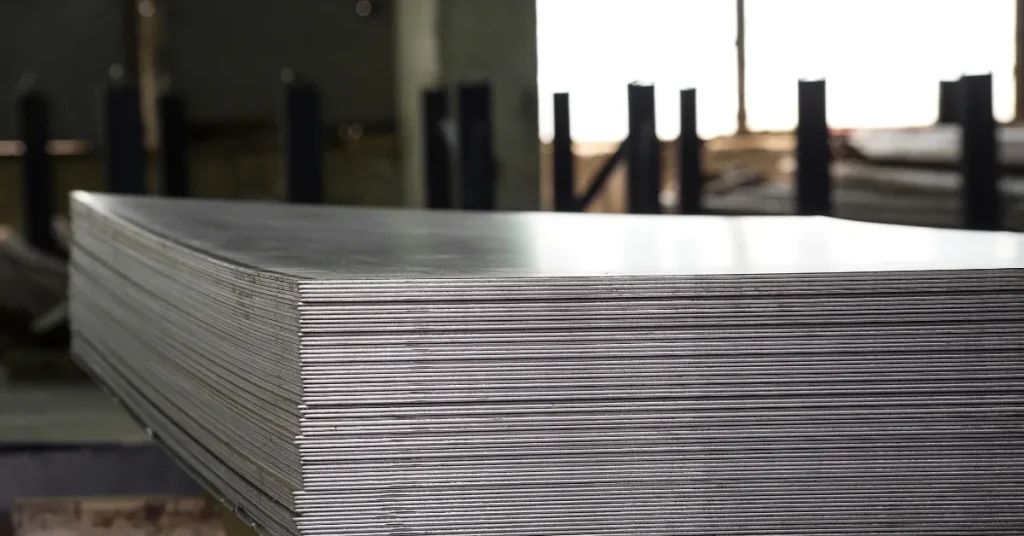18 gauge stainless steel is approximately 0.05 inches or 1.27 millimeters thick. This specific thickness balances durability with workability.
In the realm of metals and construction, thickness holds significant sway over a material’s application and performance. Stainless steel, known for its corrosion resistance, becomes a versatile player at 18 gauge.
This thickness is often found in household appliances, automotive parts, industrial equipment, and architectural elements.
Designers and builders rely on this gauge for items that require a medium level of strength without excessive weight, making it a go-to choice for a variety of projects.
Due to its popularity, 18 gauge stainless steel is readily available, offering a cost-effective solution that does not compromise quality.
Understanding its dimensions enables professionals and DIY enthusiasts alike to select the appropriate gauge for their specific needs.

18 Gauge Stainless Steel Unveiled
In the world of metals, stainless steel stands out for its strength and shine. 18 gauge stainless steel is commonly used. But how thick is it? Let’s take a deep dive into this versatile material to understand it better.
Defining Gauge In Metalworking
The term ‘gauge’ can be confusing. It’s a number that tells us how thick a metal is. Smaller numbers mean thicker metals. In metalworking, gauges vary by the metal type.
Let’s focus on stainless steel. Each gauge number in stainless steel represents a specific thickness in inches or millimeters.
| Gauge Number | Thickness (Inches) | Thickness (Millimeters) |
| 16 Gauge | 0.0625″ | 1.59mm |
| 18 Gauge | 0.05″ | 1.27mm |
| 20 Gauge | 0.0375″ | 0.95mm |
Comparing 18 Gauge To Other Thicknesses
Now, let’s compare 18 gauge steel to other thicknesses. You will see it is not as thick as 16 gauge but thicker than 20 gauge. It’s a middle option. Great for many projects.
- 16 Gauge: thicker, stronger, heavier.
- 18 Gauge: thinner than 16, still durable, lighter.
- 20 Gauge: even thinner, most flexible, lightest.
Measuring The Thickness
When delving into the world of stainless steel, understanding the dimensions is key. ‘Measuring the Thickness’ becomes an essential process for professionals and hobbyists alike.
It determines the durability and application of the material. In this section, we look closely at how thick 18 gauge stainless steel really is.
The Standard Thickness Of 18 Gauge
The 18 gauge stainless steel holds a standard thickness often utilized in various projects. This gauge is frequently selected for:
- Kitchen appliances – for its resistance to wear and tear.
- Automotive parts – providing strength without excessive weight.
- Industrial equipment – due to its ability to withstand harsh conditions.
Conversion To Millimeters And Inches
Converting the thickness of 18 gauge stainless steel to millimeters and inches ensures precision in various applications. Here’s the conversion:
| Gauge | Millimeters (mm) | Inches (“) |
| 18 | 1.02 | 0.04 |
Knowing the exact measurements helps in making informed decisions for your project requirements. Whether it’s for construction, crafting, or custom fabrication, precise data is a prerequisite.
The Fabrication Process

The journey of creating the versatile 18 gauge stainless steel is fascinating. Knowing its thickness is essential in applications ranging from kitchen utensils to industrial equipment.
But to truly appreciate the value of this material, let’s delve into the methods used in its production.
How 18 Gauge Steel Is Manufactured
The fabrication of 18 gauge stainless steel starts from sturdy, raw stainless steel. Manufacturers use advanced tools and techniques to turn this raw material into thin sheets.
The thickness of 18 gauge steel is approximately 0.048 inches or 1.2 millimeters. This precise thickness requires controlled manufacturing processes.
Cold Rolling Techniques
Cold rolling is a key step in producing the consistent thickness of 18 gauge steel. Here’s how it works:
- Large stainless steel slabs are heated at high temperatures.
- They are then passed through rolls in a mill.
- The rolls compress the steel, making it thinner and longer.
- During cold rolling, the steel is not heated. This enhances its strength.
- Finally, the steel achieves a uniform thickness.
This method grants the steel its desired properties, such as a smooth finish and enhanced hardness. Thus, the cold rolling technique is vital.
| Step | Description | Outcome |
| Heating | Steel slabs heated at high temperatures. | Preparation for compression. |
| Compression | Rolling through mill to thin the steel. | Increased length and reduced thickness. |
| Cold rolling | Further thinning without heat. | Smooth finish and hard steel. |
Properties Of 18 Gauge Stainless Steel
Let’s peel back the layers of 18 gauge stainless steel and discover its core qualities. Common in kitchen appliances, this material is a favorite among professionals and DIY enthusiasts alike. To truly understand its value, we delve into its key properties.
Strength And Durability
Among metals, 18 gauge stainless steel stands out for its impressive strength. Its rigidity makes it a tough match against impacts and heavy weight. Daily use barely leaves a dent, thanks to its high tensile strength.
This strength is measured in pound-force per square inch (psi). Durable and reliable, this steel gauge ensures longevity in products and structures.
- High resistance to physical impacts
- Consistent performance under heavy loads
- Long service life, offering value over time
Corrosion Resistance
18 gauge stainless steel boasts an innate ability to resist rust and oxidation. This is thanks to its chromium content, usually above 10.5%. When exposed to oxygen, it forms a thin protective layer.
This barrier shields the steel from water and air that might cause rust. In environments with moisture or chemicals, this steel gauge maintains its integrity and appearance. Its resistance varies with its grade, including 304 or 316 types.
These grades are particularly known for their excellent corrosion resistance.
| Stainless Steel Grade | Corrosion Resistance Level |
| 304 | High |
| 316 | Higher |
Practical Applications
Imagine a material crucial in many parts of your daily life. 18 gauge stainless steel is that material. It’s a popular choice because of its strength and thinness.
18 gauge measures 0.048 inches, or around 1.2 millimeters. Its thickness makes it perfect for many uses. Let’s delve into its real-world applications.
Use In Construction
Construction demands materials that last and protect. 18 gauge stainless steel fulfills these needs. Builders use it for:
- Durable roofing
- Sturdy wall cladding
- Reliable HVAC systems
Its resistance to corrosion means buildings stand strong for years. This gauge balances weight and strength, making construction processes smoother.
Importance In Automotive Industry
The automotive industry values safety and durability. 18 gauge stainless steel is the hero in this arena. It is used for:
| Automotive Part | Use |
| Exhaust systems | Handles high temperatures |
| Trim moldings | Adds aesthetic appeal |
| Structural components | Increases chassis rigidity |
It helps ensure that vehicles remain reliable and safe over time. The thickness is just right for parts that need to be strong yet lightweight.
Applications In Consumer Products
Everyday items around us contain 18 gauge stainless steel. Its thickness is ideal for products that need to be light yet sturdy. Examples include:
- Kitchen sinks that resist wear and tear
- Appliances like refrigerators and ovens that handle frequent use
- Medical equipment that demands sanitation and durability
It’s a favorite in consumer goods for its balance of form and function. Our homes and hospitals are better places thanks to this versatile material.
Choosing The Right Gauge

Imagine trying to pick a new stainless steel kitchen sink. Thickness matters! In the world of metals, we measure thickness in ‘gauge’. A lower number means a thicker sheet. Think of 18 gauge stainless steel as the sweetspot for durability and versatility.
Yet, how thick is it? It stands at about 0.05 inches or approximately 1.27 millimeters. That’s strong enough for kitchen sinks but what about your project? Let’s dive into the factors that help pick the right gauge.
Factors To Consider
Before you choose, ask these questions:
- What’s the purpose? Is it for heavy-duty use or aesthetic appeal?
- Will it face pressure? Can it handle the weight and use it will face?
- Where’s it going? Inside, outside, wet areas?
- What’s your budget? Higher gauge may cost more.
Cost Implications
Thicker isn’t always pricier. It depends on the steel type and finish. Check this:
| Gauge | Approximate Thickness (in) | Cost (Depends on market) |
| 16 | 0.0625 | $$$ |
| 18 | 0.05 | $$ |
| 20 | 0.0375 | $ |
Remember, prices vary based on size, grade, and finish.
Weight And Structural Considerations
Heavier doesn’t mean stronger. Think about the structure. Here’s a quick look at weights for a 4’x8′ sheet:
| Gauge | Weight (lbs) |
| 16 | 80 |
| 18 | 65 |
| 20 | 50 |
Your project’s needs dictate the best balance of weight and strength.
FAQs About How Thick Is 18 Gauge Stainless Steel
How Thick Is Stainless Steel 18ga?
Stainless steel 18 gauge measures approximately 0. 048 inches or 1. 2 millimeters in thickness. This measurement is common for various applications, including industrial and household items.
Which Is Thicker 16 Or 18 Gauge Stainless Steel?
16 gauge stainless steel is thicker than 18 gauge. It’s typically used for heavier duty applications due to its increased thickness and strength.
What Is 18 Gauge In Inches?
An 18 gauge wire measures 0. 0403 inches in thickness. This thickness can vary slightly between different types of materials, but it typically represents a standard for wires and sheet metal.
Is 18 Gauge Stainless Steel 304?
18 gauge refers to the thickness of the metal, not its grade. Stainless steel 304 describes the composition of the material. Both attributes are independent; thus, 18 gauge stainless steel can be of 304 grade, but not exclusively.
Conclusion
Understanding 18 gauge stainless steel’s thickness helps in making informed decisions for your projects. At approximately 0. 048 inches, its durability and versatility shine in various applications.
Remember this gauge’s balance between flexibility and strength for your next endeavor. Choose wisely and your results will reflect the quality of your materials.
